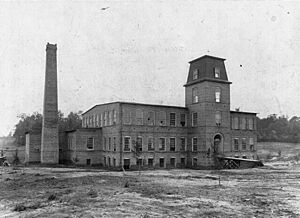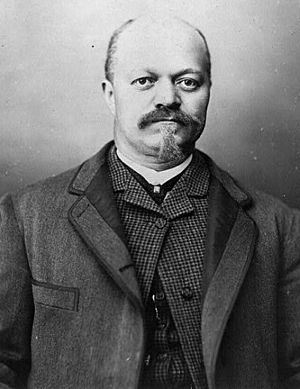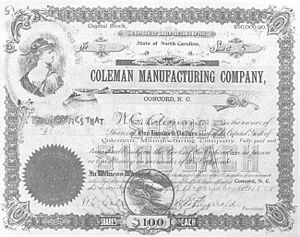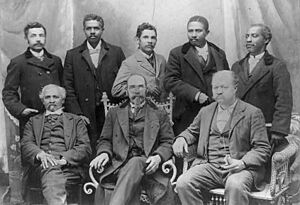Coleman Manufacturing Company facts for kids
The Coleman Manufacturing Company was a very special business that operated from 1899 to 1904. It was the first cotton mill in the United States to be completely owned and run by African Americans. This was a big deal because, at that time, most cotton mills only hired white workers for important jobs.
The company was started in 1897 by Warren Clay Coleman and other important leaders. It was located in Concord, North Carolina, a town in the Piedmont area. The mill building is still around today! It's now called the Coleman-Franklin-Cannon Mill and is used by a company called Southern Grace Distilleries. Because of its important history, it was added to the National Register of Historic Places in 2015. Pictures of the mill were even shown at a special exhibit in Paris, France, in 1900, to show how much African Americans were achieving.
Contents
Starting the Company (1897)
The Coleman Manufacturing Company was created in 1897 in Concord, North Carolina. It was mainly started by African American business leaders, many from Wilmington. Their main goal was to help African Americans gain economic security. They wanted to build a cotton mill that would be fully managed and run by Black people. This was important because, back then, most cotton mills in the South only hired Black workers for low-paying, difficult jobs.
The first president of the company was Richard B. Fitzgerald, a successful brickmaker. Edward A. Johnson was the first vice-president. Warren Clay Coleman from Concord was the first secretary, treasurer, and manager. Other important people were on the first board of directors, including John C. Dancy.
Many African Americans, especially those living near Concord, invested in the company. They raised about $50,000, which soon grew to $100,000. A few white supporters also invested. For example, Benjamin N. Duke invested $1,000. Washington Duke, a rich tobacco businessman, loaned the company $20,000 to help start building the mill.
Building the Mill
The plans for the mill were big. It was designed to have between 7,000 and 10,000 spindles and 100 to 250 looms. These are machines used to spin cotton into thread and weave it into cloth. The company's official permission, called a state charter, allowed them to make and sell many types of cotton fabrics.
The mill was planned to have a powerful engine and modern machinery. However, Coleman bought used equipment, which some people said was not very good. This older equipment later caused problems with production.
On February 8, 1898, the first stone of the mill building was laid in a special ceremony. The building was made of brick, three stories tall, and measured 80 by 120 feet. By April 1900, several four-room houses for the mill workers were also built. Workers could rent these houses for about $3 per month.
At first, local Black workers and builders accepted company stock as payment for their work on the mill. But many soon wanted to be paid in cash instead. Because the company had trouble raising enough money at that time, many workers quit.
Mill Operations and Challenges
The mill building was finally finished in 1901. In July of that year, Warren Coleman told investor Washington Duke that the mill was running well. Black workers were hired and had the chance to learn important industrial skills. This was a huge step forward for them.
However, the mill soon faced financial problems. The price of cotton became very high, which made it harder for all cotton manufacturers to make a profit. In 1902, the mill had to temporarily close down its operations.
Mill Closure (1904)
By 1904, the company could no longer stay open financially. Warren Coleman, the leader, also passed away, which was a big loss. Because of these problems, the company decided to sell the mill in July 1904. Washington Duke bought it for $10,000. He later sold the property in 1906 for $13,000.
The Mill Building Today
The original mill building is still standing. It became part of a larger factory complex called Fieldcrest Cannon Plant #9. Today, it houses the production facilities of Southern Grace Distilleries, Inc.
Legacy and Honors
The Coleman Manufacturing Company left an important mark on history.
- Photographs and a description of the mill were shown at the Negro Exhibit during the Paris Exposition of 1900 in France. This exhibit was put together by an American sociologist named W. E. B. Du Bois. It aimed to show the progress and achievements of African Americans.
- In 2001, a section of Highway 601 South near the mill was named "Warren C. Coleman Boulevard" to honor Warren C. Coleman.
- In 2015, the Coleman-Franklin-Cannon Mill was added to the National Register of Historic Places. It was recognized for its importance as the first textile mill in the United States to be owned and operated by African Americans.





